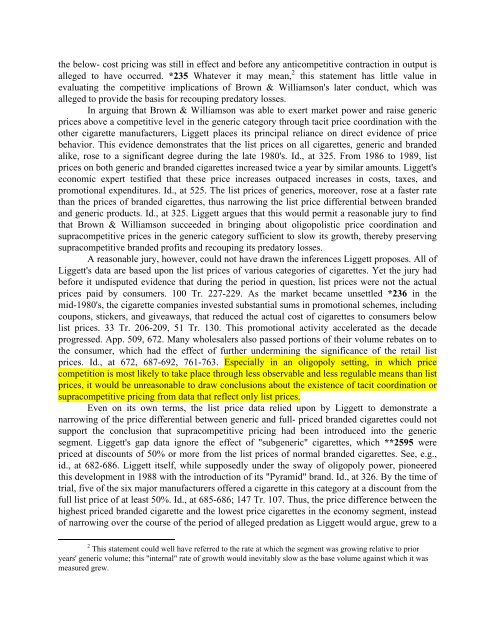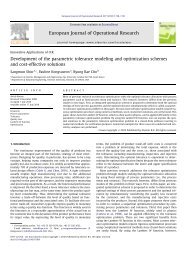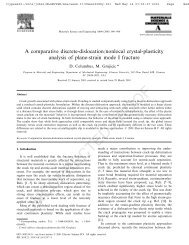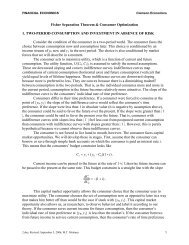509 U.S. 209, 113 S.Ct. 2578 BROOKE GROUP LTD., Petitioner v ...
509 U.S. 209, 113 S.Ct. 2578 BROOKE GROUP LTD., Petitioner v ...
509 U.S. 209, 113 S.Ct. 2578 BROOKE GROUP LTD., Petitioner v ...
Create successful ePaper yourself
Turn your PDF publications into a flip-book with our unique Google optimized e-Paper software.
the below- cost pricing was still in effect and before any anticompetitive contraction in output is<br />
alleged to have occurred. *235 Whatever it may mean, 2 this statement has little value in<br />
evaluating the competitive implications of Brown & Williamson's later conduct, which was<br />
alleged to provide the basis for recouping predatory losses.<br />
In arguing that Brown & Williamson was able to exert market power and raise generic<br />
prices above a competitive level in the generic category through tacit price coordination with the<br />
other cigarette manufacturers, Liggett places its principal reliance on direct evidence of price<br />
behavior. This evidence demonstrates that the list prices on all cigarettes, generic and branded<br />
alike, rose to a significant degree during the late 1980's. Id., at 325. From 1986 to 1989, list<br />
prices on both generic and branded cigarettes increased twice a year by similar amounts. Liggett's<br />
economic expert testified that these price increases outpaced increases in costs, taxes, and<br />
promotional expenditures. Id., at 525. The list prices of generics, moreover, rose at a faster rate<br />
than the prices of branded cigarettes, thus narrowing the list price differential between branded<br />
and generic products. Id., at 325. Liggett argues that this would permit a reasonable jury to find<br />
that Brown & Williamson succeeded in bringing about oligopolistic price coordination and<br />
supracompetitive prices in the generic category sufficient to slow its growth, thereby preserving<br />
supracompetitive branded profits and recouping its predatory losses.<br />
A reasonable jury, however, could not have drawn the inferences Liggett proposes. All of<br />
Liggett's data are based upon the list prices of various categories of cigarettes. Yet the jury had<br />
before it undisputed evidence that during the period in question, list prices were not the actual<br />
prices paid by consumers. 100 Tr. 227-229. As the market became unsettled *236 in the<br />
mid-1980's, the cigarette companies invested substantial sums in promotional schemes, including<br />
coupons, stickers, and giveaways, that reduced the actual cost of cigarettes to consumers below<br />
list prices. 33 Tr. 206-<strong>209</strong>, 51 Tr. 130. This promotional activity accelerated as the decade<br />
progressed. App. <strong>509</strong>, 672. Many wholesalers also passed portions of their volume rebates on to<br />
the consumer, which had the effect of further undermining the significance of the retail list<br />
prices. Id., at 672, 687-692, 761-763. Especially in an oligopoly setting, in which price<br />
competition is most likely to take place through less observable and less regulable means than list<br />
prices, it would be unreasonable to draw conclusions about the existence of tacit coordination or<br />
supracompetitive pricing from data that reflect only list prices.<br />
Even on its own terms, the list price data relied upon by Liggett to demonstrate a<br />
narrowing of the price differential between generic and full- priced branded cigarettes could not<br />
support the conclusion that supracompetitive pricing had been introduced into the generic<br />
segment. Liggett's gap data ignore the effect of "subgeneric" cigarettes, which **2595 were<br />
priced at discounts of 50% or more from the list prices of normal branded cigarettes. See, e.g.,<br />
id., at 682-686. Liggett itself, while supposedly under the sway of oligopoly power, pioneered<br />
this development in 1988 with the introduction of its "Pyramid" brand. Id., at 326. By the time of<br />
trial, five of the six major manufacturers offered a cigarette in this category at a discount from the<br />
full list price of at least 50%. Id., at 685-686; 147 Tr. 107. Thus, the price difference between the<br />
highest priced branded cigarette and the lowest price cigarettes in the economy segment, instead<br />
of narrowing over the course of the period of alleged predation as Liggett would argue, grew to a<br />
2 This statement could well have referred to the rate at which the segment was growing relative to prior<br />
years' generic volume; this "internal" rate of growth would inevitably slow as the base volume against which it was<br />
measured grew.
















